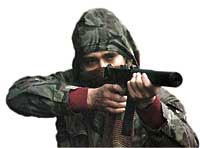INLA
Irish National Liberation Army − Irlanda
 Conosciuto anche come:
Conosciuto anche come:People's Liberation Army (PLA)
People's Republican Army (PRA)
Catholic Reaction Force (CRF)
A war for national liberation continues in Ireland today, which traces its roots to the original conquest of the island by Britain in 1167. In its most current phase, this war has centered on bringing to an end the continued occupation by Britain of six counties in Northeast Ireland. The Irish Republican Socialist Party (IRSP) and Irish National Liberation Army [INLA] were founded on December 10, 1974. Most original members were drawn from Official Sinn Fein and the Official IRA (the organizations from which the Provisional Irish Republican Movement had split five years earlier). INLA, which initially used the name People's Liberation Army (PLA) and has also used a number of covernames including People's Republican Army (PRA) and Catholic Reaction Force (CRF), is a radical terrorist group dedicated to removing British forces from Northern Ireland and unifying Ireland. The object of the INLA remains a 32-county socialist republic, wherein the Irish working class will control the means of production, distribution and exchange, administered by the proletariat through workers' democracy.
Activities
While acknowledging that national liberation and socialism cannot be achieved through a military victory by guerrilla forces in the national liberation campaign, the IRSP defends the right of the revolutionary forces to employ this tactic whenever useful to achieve its aims. The Party also understands that no parliamentary road to socialism exists, and feels no compulsion to participate in all electoral campaigns, but is prepared to use parliamentary politics and hold elective office as a means of carrying out propaganda, and where possible to aid the self-organization of the working class towards winning immediate objectives.
INLA activities have included bombings, assassinations, kidnappings, extortion, and robberies. During the 1980s, the INLA continued to engage the occupation forces in the Six Counties while also carrying out military actions that underlined the character of its political line, such as assassinations of Loyalist paramilitarists like John McKeage of the Red Hand Commandos and the bombing of the Mount Gabriel radar station near Cork, Ireland. Since August 1994 the INLA held to a 'No First Strike' policy of not initiating any offensive military action, while continuing to respond in actions against the Royal Ulster Constabulary (RUC). INLA recently ended its no first strike policy in the wake of the Good Friday Agreement.
Jailed loyalist terrorist leader Billy Wright was shot five times at close range by three Irish National Liberation Army gunmen at the top security Maze prison on 27 December 1997. Wright was the leader of the LVF loyalist terrorist organization. Riots followed that evening when loyalist gangs in Portadown and other towns hijacked and burned cars and attacked police with Molotov cocktails. In retaliation for Wright's killing, three men opened fire in front of the Glengannon Hotel on December 28, killing 45-year-old former IRA terrorist and convicted murderer (released in 1994) Seamus Dillon. Three others, including a 14-year-old boy, were wounded. The LVF claimed responsibility for the attack, as well as a subsequent new year's eve attack on a North Belfast bar which fatally wounded 31-year-old Catholic Eddie Treanor.
Strength
Several dozen, plus several hundred sympathizers.
Location/Area of Operation
Northern Ireland, Irish Republic, Great Britain, and Europe.
External Aid
Has received aid from a variety of groups and countries and considerable training and arms from Libya and, at one time, the PLO. Also is suspected of receiving funds and arms from sympathizers in the United States. Similarities in operations suggest links to the ETA.


